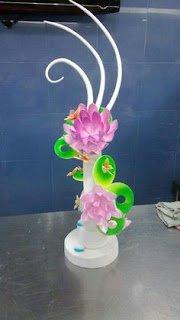Introduction To Torten
The most well-known of the typical tortes include the Austrian Sachertorte and Linzertorte, the German Schwarzwälder Kirschtorte, and the many-layered Hungarian Dobos torte. But other well-known European confections are also tortes, such as the French Gâteau St. Honoré.
Mostly, in Poland, Ukraine, Russia cakes are called tortes without certain difference between cake and torte. Fo Polish, as an axample? English torte is translated into Polish as tort, but tort is a more often used word and can be also translated as for example layer cake or cream cake. Birthday cake is tort urodzinowy and wedding cake is tort weselny (general word for cake is ciasto). Diminutive of tort, torcik is translated as tart or gateau.
·
Many classic European-style fro American –style cakes
generally have most fat baked into the cake .
·
European torte mainly consist of layer of low fat cake
such as genoise and spongecake that may be moistened with flavoured simple
syrup.
·
Cake
-
American & British
-
Refer broad range of pastries includes the cake,
sponge cake, layer cake, coffee cake.
-
Refer to almost everything that is baked, tender,
sweet.
·
Entrement
-
France describe a torte (layer of spongecake mousse
and other filling).
-
Refers to dish served in between courses or on the
side.
·
Gateau
-
French refer as a various pastry items made with puff
pastry, éclair paste, short dough/sweet dough .
-
But in America they assume that all gateau are cake
type of dessert.
·
Torte
-
Central & Eastern European countries refer torten
as rich cake which all part of flour is replaced with finely chopped nuts &
breadcrumbs.
-
Other refer any round sweet cake as torte.
·
One of the popular is Sacher torte (ClassicTorten)
-
Very well known on a viannese table.
-
Vianese table : Lavish dessert buffet offered at
receptions & catered event featuring with an assortment of slice tortes,
elegant pastries, mousses, fruits and confections.
Modern Tortes
·
Not many different b between classic and modern
tortes.
·
The different is in types of:
size
-
Before this it’s a whole cake decorate and presented
to the customer.
-
Recently its already slices/portions/ various size.
Customer can see the layer of the cake and can attract them to buy.
-
Cause it is more
flexible form to be presented and this can attract customer to try new
dessert.
-
Petit four of sliced cake is actually miniature torte.
Filling For Modern Torte
·
Example of classic torte is black forest which filled with whipping cream.
·
For modern torte, ganache, buttercream, mousse that is
stabilized with gelatin can be used for modern torte.
·
To choose the filling :
-
It cannot something that too creamy which can cause
the cake to become too soft and make the tort soggy.
-
To use the gelatin, it is for the purpose to make it
set. This will make the torte more nice when it is being cut.
·
Slice of torten approximately popular as a afterdinner
sweet especially in germany & Switzerland or mostly known as 1 type of
dessert serve to be eaten with coffee or tea.
·
There are few interpretation that any large size of
gateau also known as torte.
·
Generally accepted that a large gateau already divided
into number of wedges-shapes slices which are individually decorated.
·
Basically made from sponge cake, soaked with
liquared-flavoured syrup, layered with buttercream (can be substitute with any
other cream) and mounted on a disc or either sweetpaste or japonaise.
-
Japonaise
Meringue
layered with ground toasted almonds.
Great
with ganache or buttercream.
Have
a light & heavy texture.
Recipe
for Japonaise:
Ø 1 1/4 Cup ground almond
Ø 1/4 Cup fine sugar
Ø 1/4 Cup cornstarch
Ø 5 Egg white
Ø 2/3 Cup fine sugar
Ø Prep time : 25 min 350°F
Recipe
For Buttercream
Ø 1 Cup
superfine sugar
Ø 3/4 Cup water
Ø 1 Tbsp
coffee extract
Ø 6 Nos egg
yolk (beaten lightly)
Ø 8 Oz cold butter.
Torten Types
·
Usually will be layered for at least or more layers like sandwich with buttercream
or any suitable alternative.
·
If used fruits, 2 layered of sponge cake is
sufficient.
·
Usually sold as sliced rather than a large gateau.
·
That’s the reason the cut look need to look attractive
rather than normal cake.
·
If using a fruits, it is advisable to be put as whole
or half so that it will be clearly shown when the gateau being cut.
size
·
Height : not exceed 6.5 cm.
·
Diameter : 20 – 30 cm
·
20 cm may produce 12- 16 slices while 30 Cm may
produce 24 slices.

















